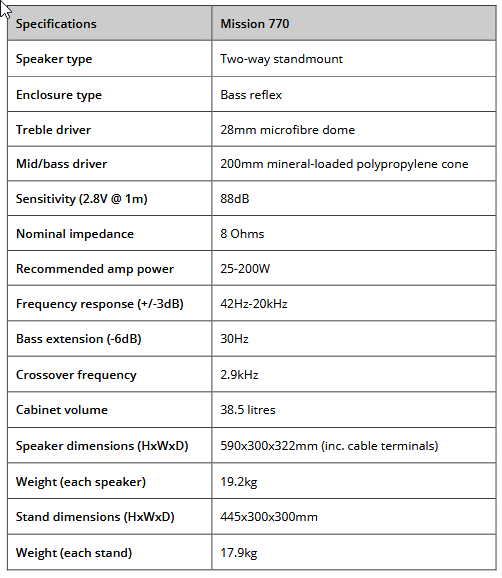
Mission 770 Loudspeakers
Classics rock Mission resurrects a classic speaker from its formative years, the iconic Mission 770, re-engineering the design to fuse vintage style with cutting-edge performance – and made in the UK too! Cambridgeshire, England – Mission is one of Britain’s best-loved loudspeaker brands, established on 07/07/1977 by the late Farad Azima (who was famously fond of the number seven). The following year, Mission launched a speaker that rocketed the company to the forefront of the burgeoning British hi-fi scene – the highly influential Mission 770.
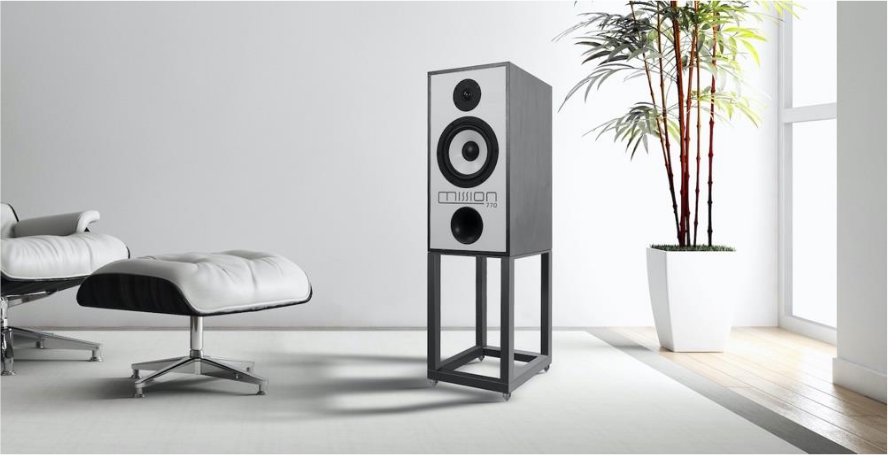
44 years on from its debut and Mission is bringing back the 770 – re-engineered to reap the benefits of modern techniques and technologies whilst invoking the spirt of the original in terms of technical ethos, look and sound. The appeal of the Mission 770 was always the way it sounded.
That might seem obvious, but it was born in a time when subjective evaluation through listening tests was secondary to technical specifications – both in terms of how products were designed and how they were reviewed. On the face of it, the original 770 did not appear especially radical, despite its distinctive white baffle and clever engineering. But crucially, its sound was perfected over hundreds of hours of listening tests with input from budding industry luminaries such as Philip Swift and Derek Scotland (soon to be founders of Audiolab), and magazine editors such as Paul Benson of Hi-Fi Answers and John Atkinson of Hi-Fi News. This gave it an edge over the competition and a reputation for exemplary sound was quickly earned.
The project was a labour of love for Farad Azima. His intention was to deliver the BBC-influenced midrange accuracy and transparency of a speaker like the Spendor BC1 while also achieving tighter bass and a more propulsive and engaging sound. It was a breath of fresh air that put the music first and gave definition to the term ‘musicality’. This was the essence of its success.
Key elements: the drive units
A new 20cm polypropylene mid/bass driver was developed for the re-engineered 770, mimicking the extended response and low coloration of the original, while upgrading the motor system to take account of modern power handling and dynamic requirements. Like the original, the driver is built onto a die-cast chassis with large rear ‘windows’ to reduce early reflections back through the cone. Special care has been taken to marry a low-density nitrile surround to the cone, to match its impedance and reduce reflections from the cone edge.
The new polypropylene cone is loaded with minerals to make it stiffer than the original, yielding fast, tight bass that enables the listener to hear exactly how bass instruments are being played. This is balanced by tuning the cabinet and reflex port to a very low frequency, avoiding the ‘one note bass’ that is typical of a lot of bass reflex systems. In addition, the port is strongly flared at both inlet and outlet to smooth airflow and eradicate distortion. Bass extends powerfully and cleanly to below 30Hz in room, which is remarkable for this size of speaker.
In the original 770 design, Farad Azima focused on the midrange performance, which was always the strength of hi-fi reproduction from vinyl records. For today’s digital sources and superior turntables, the performance of a speaker at the frequency extremes is now considered of equal importance to the midrange. The new 770’s treble unit uses a lightweight, damped microfibre dome with an ultra-smooth response, backed by a damped rear chamber that pushes the fundamental resonance well below the crossover region. The quality of this 28mm dome marries perfectly with the mid/bass driver to ensure evenness of character throughout the range of the whole speaker.
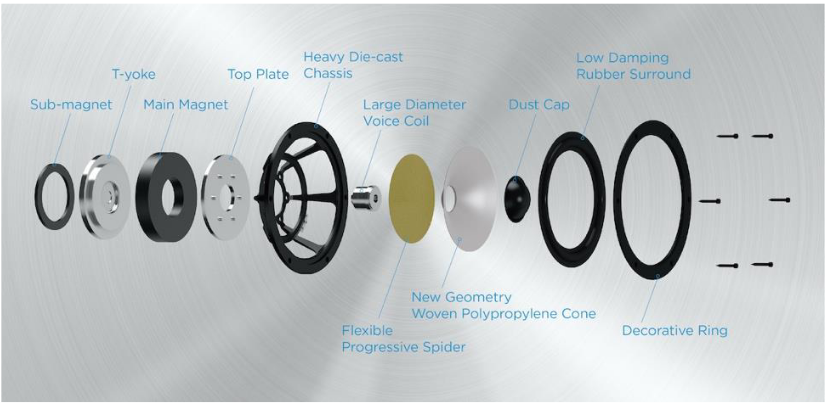
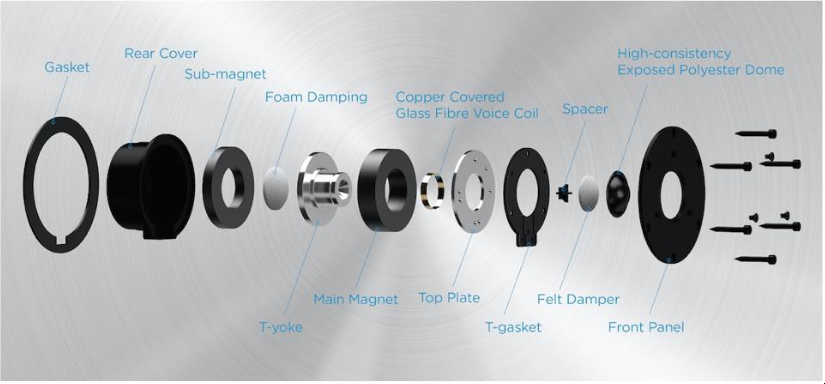
the crossover
The original 770 used a single coil to equalise the bass to midrange response as well as cross over to the treble unit, the latter driven by a resistor, capacitor and coil combination. Using just these components to perform both functions was always going to be a compromise, and this is likely the reason why Farad Azima could not resist tinkering with the crossover and producing so many variants. Today’s advanced software crossover mapping and measuring techniques allow Mission to perfect the balance between bass and midrange and adjust the crossover to the treble unit by mapping the acoustic crossover slopes with extreme accuracy. Even so, the choice of EQ and crossover for the new 770 involved hundreds of hours of listening sessions using a wide variety of music, and over 170 circuit iterations were tried before the final crossover was settled upon.
The circuit was then mapped out onto separate bass and treble PCBs using very short signal paths and accommodating high-quality components such as super-transparent polypropylene capacitors and air core inductors, maintaining the simplicity and elegance of the original whilst improving critical elements. The resulting transparency to musical detail ensures the thrilling emotion of music is fully conveyed, whilst maintaining a seamless transition between the mid/bass and treble units.
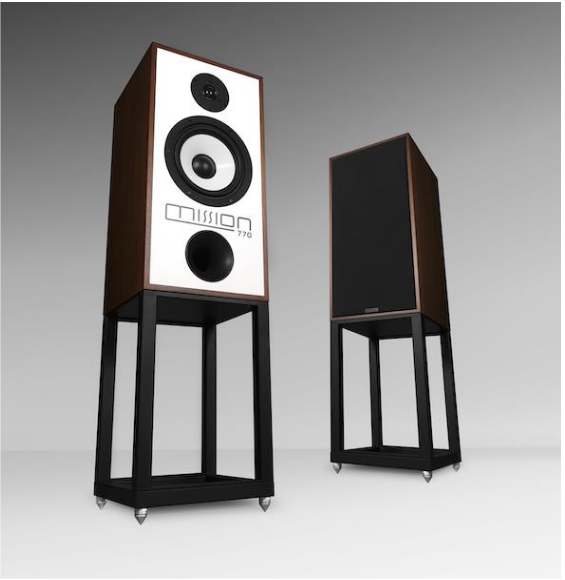
the cabinet
The drivers and crossover are housed in a real-wood veneered cabinet, measuring 59x30x30cm (HxWxD), with a white laminated front baffle echoing the style that made the Mission 770 a stand-out hi-fi product in the 1970s and ’80s. Beneath the rich, rosy-tinged walnut or black veneers lies a further technological advancement. While the original 770 reduced midrange coloration using the BBC-influenced technique of a thin-wall cabinet damped by mass loading with bitumen pads, the new 770 features a twin-wall sandwich of high-density MDF and particle board bonded by a layer of high-damping adhesive. This results in a cabinet with panel resonance well below audibility, allowing the drive units to do their job unsullied by cabinet coloration at all frequencies.
Internal bracing adds strength to the front baffle and braces the drive unit to the cabinet, creating a mechanical support that aids the dynamic performance of the bass unit and reveals the micro- dynamics of the musical performance. This is complemented by a layer of acoustic foam and damping fibre, strategically placed to absorb reflections inside the cabinet without overdamping the bass quality. Peter Comeau is justly proud of what he and Mission’s acoustic engineering team have achieved. Speaking about the launch, Peter said: “To repeat the original 770 brochure’s claims of ‘staggering bass definition and response; lack of coloration; uncanny imaging; information retrieval; transient attack; depth and perspective; accuracy and linearity; speed and dynamic range’ is only to hint at the true capabilities of the new 770. Instead, we prefer to focus on its uncanny ability to reveal the true depth, emotion and drama of whatever music you care to feed to it. A much-loved British hi-fi classic has been emphatically reborn.”
